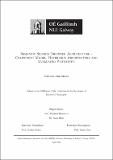| dc.description.abstract | This dissertation presents a component model, reference architecture and peer-evaluated prototype for Semantic Service Oriented Architecture (SSOA). Semantic Web service technology, derived from the combination of the Semantic Web and Web services, is the enabling-technology for SSOA.
Allowing the semantics of the public data and process model of Web services to be unambiguously communicated to potential service-consumers, provides the basis for Web services to be discovered, composed, and invoked as needed. The alternative is that these actions must be carried out manually in advance.
The thesis is motivated by the fact that, although a body of research has developed into many aspects of Semantic Web services, a gap remains between conceptual models and languages for Semantic Web services on the one hand, and prototype implementations using those models and languages, primarily for service discovery, on the other. Filling this gap requires a combination of top-down and bottom-up approaches.
From a top-down perspective, the absence of a reference software architecture model, as distinct from a conceptual model, for Semantic Web services gives rise to a number of shortcomings in the body of knowledge.
These include the identification of a minimal component model for an SSOA, defining corresponding behavioural and component communication models and, validating this architecture, both experimentally and qualitatively so that it can be regarded as a reference point for further research. Experimental validation is achieved by peer-review, through the application of a prototype implementation of the SSOA to a set of open and independently specified system-integration problems. Qualitative evaluation is carried out by first determining a matrix of requirements on which the SSOA is based, and using this as the basis for relating five contemporary Semantic Web service frameworks to the SSOA.
The thesis moves on to describe how research challenges arose in the course of building and validating the prototype SSOA implementation. Two specific challenges were in the areas of (1) Semantic Web service discovery where incomplete data, available in the service description, must be augmented by fetching additional data at the time the service is required, and (2) the enactment of process mediation between the public interface descriptions of a service requester and a matching Web service offer. Devising solutions to these problems, applying them to real-world problems and evaluating their outcomes both experimentally and qualitatively represents problem-driven contributions of this thesis from a bottom-up perspective. | en_US |


